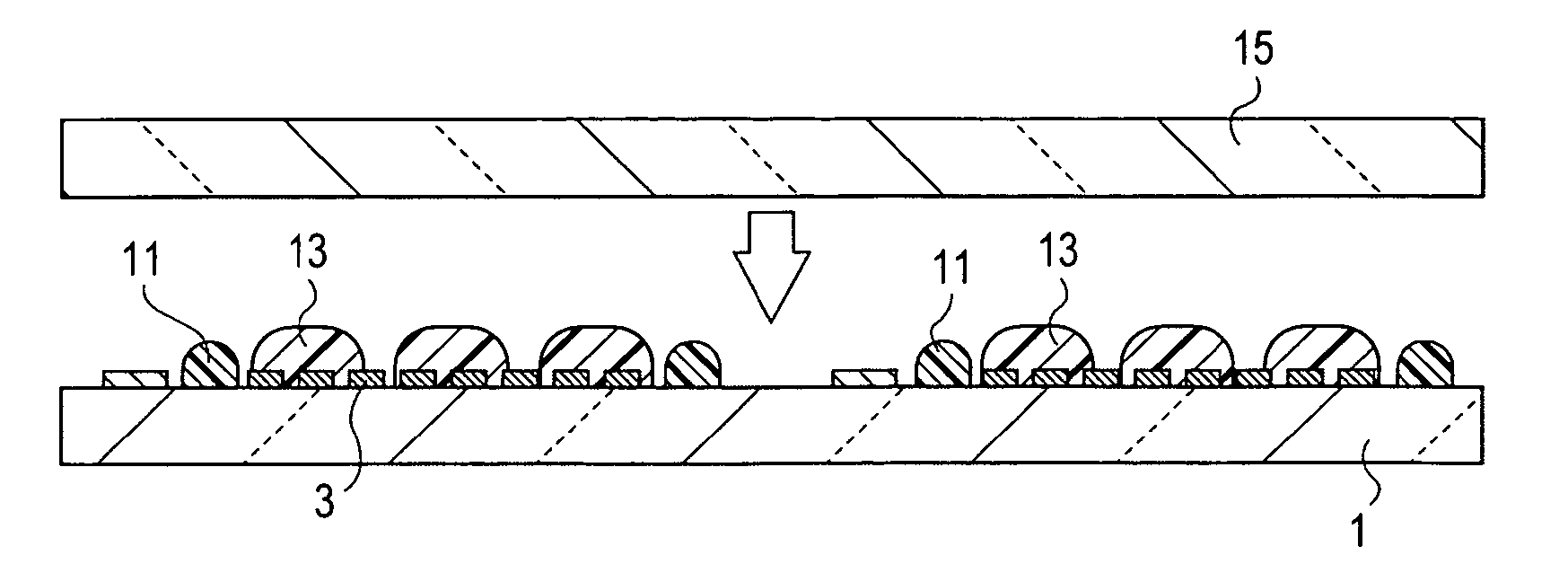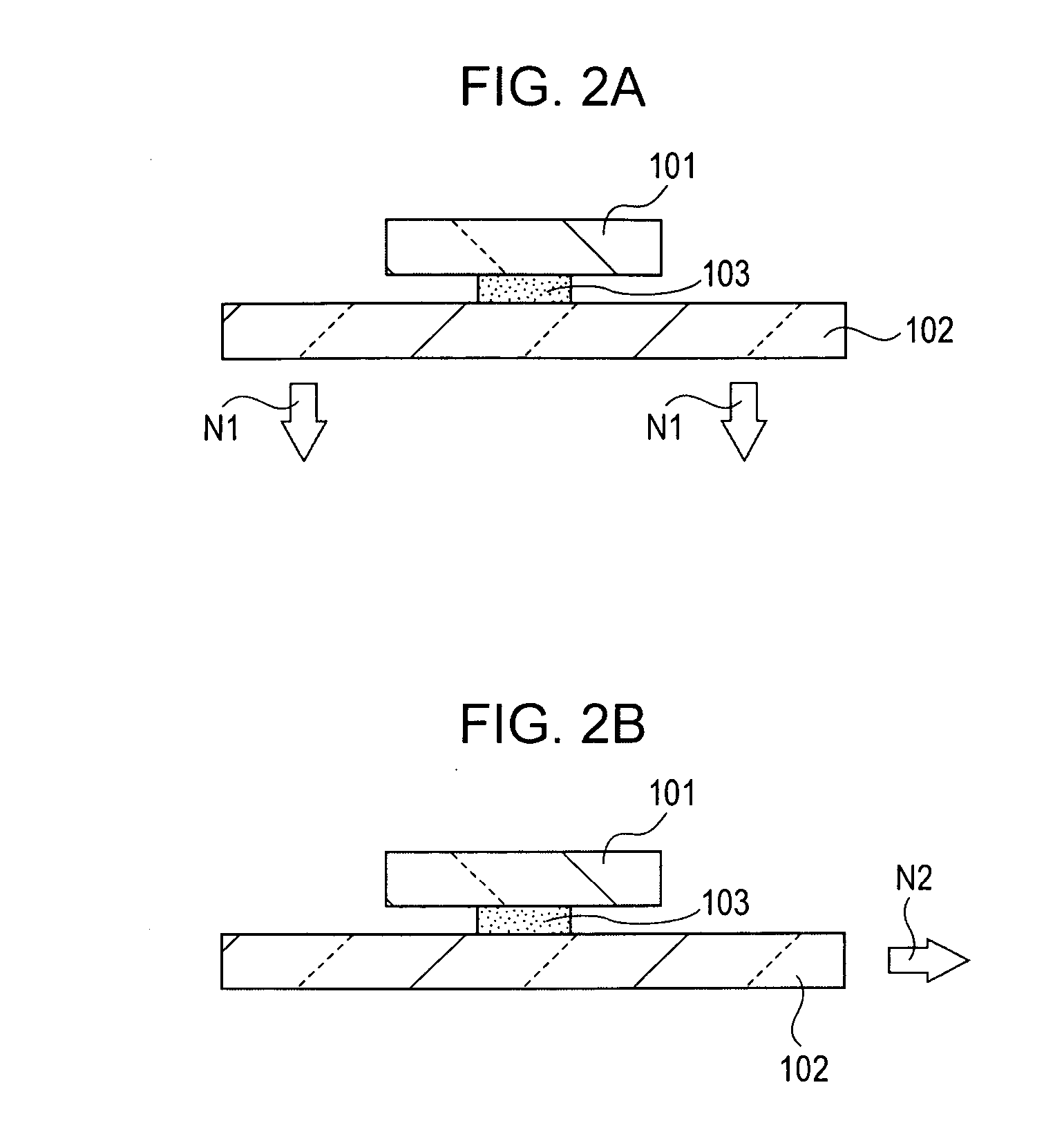Display device and method for manufacturing the same
a technology of display device and substrate, applied in the direction of identification means, instruments, cycles, etc., can solve the problems of reducing brightness, liable to be degraded, and affecting the appearance of display device, so as to reduce the distance between the base substrate and the sealing substrate, and the thickness of the display device can be further decreased.
- Summary
- Abstract
- Description
- Claims
- Application Information
AI Technical Summary
Benefits of technology
Problems solved by technology
Method used
Image
Examples
first embodiment
[0026]FIGS. 1A to 1D are each a cross-sectional view of a display device in process for illustrating a manufacturing method according to this embodiment, and the display device is manufactured as described below.
[0027] First, as shown in FIG. 1A, a base substrate 1 is prepared. This base substrate 1 may be formed of a glass material such as a non-alkaline glass and may also be formed, for example, of a plastic material or a film material partly including polycarbonate, polyester, poly(ether sulfone), polyimide, or the like. In addition, on one major surface of the base substrate 1, a plurality of device portions C is provided. In a display region a which is located at the center of each device portion C on the base substrate 1, organic electroluminescent devices 3 are arranged in a matrix, which are connected to respective drive circuits not shown in the figure. In addition, terminal electrodes 5 connected to the respective organic electroluminescent devices 3 are formed in a perip...
second embodiment
[0071]FIGS. 4A to 4D show a method for manufacturing a display device, according to the second embodiment. The difference of the method shown in the figures according to the second embodiment from the above method according to the first embodiment is that the second resin material for sealing the organic electroluminescent devices is formed from a slow-curing resin. The method of this embodiment is performed as described below.
[0072] First, in a step shown in FIG. 4A, as is the case of the first embodiment described with reference to FIG. 1A, the organic electroluminescent devices 3 are formed in an array in the display region a of the base substrate 1, and the terminal electrodes 5 are formed in the peripheral region b.
[0073] Subsequently, as shown in FIG. 4B, a first resin material 21 is formed on the base substrate 1 so as to surround one display region a in which the organic electroluminescent devices 3 are provided and so as to dispose the peripheral region b in which the ter...
third embodiment
[0084]FIGS. 5A to 5D show a method for manufacturing a display device, according to the third embodiment. The difference of the method shown in the figures according to the third embodiment from the above methods according to the first and the second embodiments is that the first resin material and the second resin material are each formed of a slow-curing resin. The method of this embodiment is performed as described below.
[0085] First, in a step shown in FIG. 5A, as is the case of the first embodiment described with reference to FIG. 1A, the organic electroluminescent devices 3 are formed in an array in the display region a of the base substrate 1, and the terminal electrodes 5 are formed in the peripheral region b.
[0086] Next, as shown in FIG. 5B, the first resin material 11 composed of a slow-curing resin similar to that in the first embodiment is formed on the base substrate 1 so as to surround one display region a in which the organic electroluminescent devices 3 are provide...
PUM
| Property | Measurement | Unit |
|---|---|---|
| thickness | aaaaa | aaaaa |
| thickness | aaaaa | aaaaa |
| volume ratio | aaaaa | aaaaa |
Abstract
Description
Claims
Application Information
 Login to View More
Login to View More - R&D
- Intellectual Property
- Life Sciences
- Materials
- Tech Scout
- Unparalleled Data Quality
- Higher Quality Content
- 60% Fewer Hallucinations
Browse by: Latest US Patents, China's latest patents, Technical Efficacy Thesaurus, Application Domain, Technology Topic, Popular Technical Reports.
© 2025 PatSnap. All rights reserved.Legal|Privacy policy|Modern Slavery Act Transparency Statement|Sitemap|About US| Contact US: help@patsnap.com



